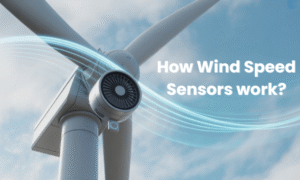
In an age where data drives decisions—from weather forecasting to wind-turbine optimisation—understanding how wind speed sensors operate is more valuable than ever. Whether you’re monitoring a rooftop weather station, optimising an industrial vent system, or tracking wind potential for renewable energy, knowing the inner workings helps you choose the right equipment and interpret its output correctly.
What is a Wind Speed Sensor?
Simply put, a wind speed sensor (also called an anemometer) is a device that converts the motion of air into measurable electrical or mechanical signals. Its purpose is to quantify how fast the air is moving, often in metres per second (m/s) or kilometres per hour (km/h). Modern versions may also detect direction, gusts, and turbulence.
The Main Types of Wind Speed Sensors
There are several ways to measure wind speed. Below are the most common sensor technologies and how they differ.
- Cup or Vane Anemometers
The classic design features rotating cups or a propeller (vane) mounted on a vertical shaft. As the wind blows, the cups spin—the faster the spin, the stronger the wind. This rotation is translated into a frequency or voltage output that correlates to wind speed.
Advantages: simple, proven, and robust.
Limitations: moving parts require maintenance and are less accurate at very low speeds. - Ultrasonic Anemometers
These sensors use pairs (or more) of ultrasonic transducers that send sound pulses across the wind path. The time-of-flight of the pulses changes depending on the wind speed: if the wind aids the pulse, it arrives faster; if it opposes it, slower. By comparing forward and reverse measurements, the wind speed is calculated.
Advantages: no moving parts, fast response, measures turbulence and direction.
Limitations: costlier and may require more calibration and clean airflow. - Thermal (Hot-Wire) Anemometers
In this method, a fine wire or film is heated and the cooling effect of airflow is used to gauge wind speed—the more airflow, the greater the cooling. This is less common in large-scale field applications but finds niche uses in research and indoor environments. - Optical or Laser Anemometers
Advanced systems use laser Doppler or optical scattering to measure particulate motion and infer wind speed. These are highly accurate but typically reserved for specialised or scientific applications.
Key Components and How They Work Together
Regardless of the type, a wind speed sensor involves several key parts:
- Sensor Element: The cups, propeller, transducers, or heated wire that directly interacts with the wind.
- Signal Conversion: Converts mechanical or physical changes (rotation, time differential, cooling) into an electrical signal.
- Processing Electronics: Filters, amplifies, and converts raw signals into calibrated data.
- Output Interface: Provides analog (0-10 V, 4-20 mA), digital (RS-485, Modbus, CAN), or wireless outputs for remote monitoring.
- Mounting & Alignment: Ensures free airflow and accurate readings, away from obstructions.
- Calibration & Maintenance: Regular checks ensure accuracy and long-term performance.
Understanding the Technical Principles
In a cup anemometer, wind blowing past the cups creates torque because one side of each cup catches more air than the other. The shaft rotates at a rate roughly proportional to wind speed—thus counting rotations over time gives a speed estimate.
For ultrasonic sensors, the measurement is based on differences in sound-pulse travel time between transducers. The faster the air moves, the greater the time difference between forward and reverse pulses. This physical principle ensures precise, real-time readings without moving parts.
These underlying laws determine critical specifications—response time, measurement range, accuracy, and direction sensitivity—all of which define sensor performance.
Practical Considerations When Selecting a Sensor
When choosing a sensor for your application, consider the following:
- Range & Sensitivity: Does it need to capture low speeds or withstand high gusts?
- Response Time: Fast sensors like ultrasonic models are ideal for turbulence and gusts.
- Durability: In harsh environments, opt for corrosion-resistant, sealed designs.
- Output Interface: Ensure compatibility with SCADA, IoT, or wireless monitoring systems.
- Directional Measurement: Some models combine both wind speed and direction.
- Installation Site: Choose a location with unobstructed, consistent airflow.
- Calibration: For precise measurements, use sensors with traceable calibration certificates.
Why Accurate Wind Speed Measurement Matters
Accurate wind speed data enables:
- Optimisation of wind turbines (cut-in, cut-out speeds, power curves)
- Reliable weather and climate modelling
- Industrial ventilation control for better energy efficiency
- Safety monitoring in high-rise buildings and bridges
- Smart city applications for air quality and environmental tracking
Poor data or a mis-mounted sensor can lead to flawed insights, wasted energy, or safety risks.
Conclusion
Understanding how a wind speed sensor works—its technology, components, and principles—empowers professionals to select the right device and use it effectively. When performance and accuracy are critical, choosing the right manufacturer makes all the difference. Logics Power AMR offers high-quality, precision-engineered wind speed sensors designed to deliver consistent, reliable data for diverse environmental and industrial applications. A well-selected sensor doesn’t just measure the wind—it helps you harness its power intelligently.
FAQs
Q1: What is the difference between wind speed and wind gust measurement?
Wind speed is typically the average value over a defined time, while gusts represent short, high-speed spikes.
Q2: Can I use a cup anemometer indoors?
Yes, but indoor airflow is often turbulent and inconsistent. For low-speed air, a thermal or ultrasonic sensor is more accurate.
Q3: How often should I calibrate my wind speed sensor?
Most manufacturers recommend annual calibration, but in harsh outdoor environments, more frequent checks may be needed.
Q4: Does mounting height affect wind speed readings?
Yes. Wind speed increases with height due to reduced surface friction, so sensors should be mounted at consistent, standard heights.
Q5: Can ultrasonic sensors measure wind direction too?
Many ultrasonic models can measure both speed and direction, making them ideal for meteorological or industrial applications.
